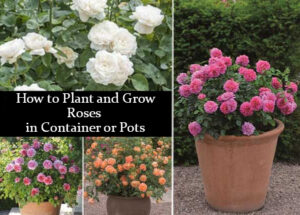Are you looking for tips about how to grow roses at home? We made a list with everything you should know, below.
Click here to see the table of contents
SPACE REQUIREMENTS
Magnificent rose gardens can be developed in surprisingly small spaces using pots and containers, providing perfumed blooms to be enjoyed in their tiny garden setting or in vases in your home.
Container roses can benefit homes that have room for traditional gardens, as well as apartments and condos that have only a balcony or patio.
If you are fortunate to have enough land for a traditional rose garden or rose bed, container roses can also be included in your landscape. Then they can be ‘auditioned’ from the garden to provide a perfect and ever-changing ‘set’ for a patio or deck or to simply ‘spotlight’ the current ‘star’ from the ‘cast’ in the rose garden.
Roses in containers, however, make it possible for families to enjoy rose gardens in very tight quarters. People are often amazed at how successful these tiny gardens can be.
Roses are hardy and forgiving, and the rewards for a little TLC are tremendous. All they need is about 5 or 6 hours of sunlight a day, watering and feeding on a regular schedule and a little protection against bad bugs and disease. In colder climates, they also need some protection from cold, harsh weather, but in a warmer environment, they can provide wonderful blooms during all 4 seasons.
Your potted roses can be enjoyed in two ways:
- You can simply enjoy the blooms in your container garden by clipping the blossoms as they fade, and thereby encouraging more growth from the plant.
- Or, you can “harvest” your blossoms by clipping vase length stems, and enjoy a steady supply of beautiful, fragrant roses in your home.
In the former scenario, the rose will enjoy more luxurious growth and may require more frequent re-potting. The second alternative will result in sparser growth, since the rose is constantly being trimmed, and may not require re-potting as frequently.
CONTAINERS
The first decision (after you have selected the cast of roses to include in your container garden) is the actual container that your roses will call home. A 10 to 15-gallon container would be ideal for a hybrid tea, a floribunda or a tree rose, and a 5-gallon container would be fine for a miniature rose.
You can be successful with smaller containers, but you would need to lavish more TLC on those plants since proper watering and feeding would be even more important.
There is a very wide variety of pots or containers to choose from; ceramic, terra cotta, wood, and plastic. Whatever you choose, the container must have a hole in the bottom to adequately drain excess water – roses do not like wet feet!
Terra cotta makes a great planter, but it is a very porous material, and you should take an extra step if you use this type of container. You need to soak it for about 24 hours before planting the rose. Otherwise, the terra cotta will simply suck moisture away from the rose at a very critical time. This also means that you have to be a little more cautious when watering the roses since this quality will constantly suck water into the material and away from the plant. Also, the porous quality of terra cotta will over time cause the material of the container to crumble away.
Plastic is great if you plan to have a lot of plants. It’s economical and easy to move (and cheaper to ship). And it comes in a variety of designs and sizes, from the “basic black dress” you find at the nurseries to beautiful pots and urns.
PLANTING MIX
Next, a good planting mix is essential. A quality rose soil mix, with extra compost, perlite or peat moss should be added to provide good moisture retention. Keeping the roses properly watered is essential since water in a container will drain away from the plant much more quickly than from one place in the ground.
Over-watering or under-watering will result in stressed or even (gasp) dead plants. Roses do like their water – in the proper amounts. A layer of mulch atop the planting mix will alleviate the evaporation of water from the mix. Remember that containers (especially black plastic ones) will absorb a lot of heat from direct sunlight. This can harm the roots and evaporate water more quickly. So, if possible, maximize the amount of sunlight on the rose itself and minimize the direct sun on the container.
PLANTING
To plant your bare root rose, first remove it from its wrapper and soak the roots in water for 24 hours. Next place a small layer of rocks or pebbles at the bottom of the container that you have selected. This is done to prevent the drainage holes from being blocked and drowning your rose. Then fill the bottom of the container with your planting mix, forming a mound in the center and tamping the mix down firmly. After checking and clipping away any obviously dead or damaged root material, fan the roots around the mound and add more mix, with about a cupful of fertilizer stirred in, until the roots are covered up to the root line. Again, tamp the mix down firmly to prevent any air bubbles, and then gently water the rose thoroughly.
FEEDING
Roses in containers will need to be fed more often than roses that have been placed in the ground. The roots will need more nutrients since they can’t expand their territory beyond the container, and nutrients will always be lost through the drainage hole while watering the plant. Roses in containers need to be fed every 2 weeks, with either a slow-release granular rose food or a liquid feeding solution. Any fertilizer should contain nitrogen, phosphorus, and potash. A common combination is 8-10-9, meaning the fertilizer contains 8% nitrogen, 10% phosphorus, and 9% phosphate. The remainder of the mix is made up of inert ingredients and small amounts of other beneficial products, such as calcium, sulfur, iron or bone meal.
DISEASE CONTROL
Although hardy and able to withstand actual abuse, roses do much better when properly protected from diseases (such as powdery mildew, black spot, and rust), and insect pests (such as aphids, spider mites, mealybugs, bagworms, thrips, and whiteflies). There are two schools of thought to this effort, the organic approach, and the classic chemical approach. Both schools have their advocates, and proper application of either material will provide the protection that your roses need to ‘ perform’ to their fullest.
- Organic: Organic treatment for roses involves spraying the plants with organic substances, such as garlic, oil of lemongrass or white pepper.
- Chemical: Chemical treatment usually consists of spraying and/or dusting with chemicals, such as nitrogen, phosphate, and potash in very small amounts.
MAINTENANCE
To keep roses from becoming root-bound in their constraining containers, after 2 or 3 years, it may be necessary to remove the rose from its pot, cut away any excess root development and replace the planting mix – which has probably become seriously depleted of necessary nutrients. The time to do this is at the onset of their dormant season after the canes have been cut back.
Although roses in containers will continue to grow and bloom throughout the year in warm climates like Southern California and Florida, in more northern latitudes you may have to provide extra protection against cold weather and freezing. In very harsh cold (below –15 degrees C), they need to be removed to an unheated garage, shelter or storage room and wrapped in insulation, such as plastic, since the roots of roses in containers are much more susceptible to freezing. You can’t forget them, though. They still need an adequate amount of moisture to survive.
If you have only a small number of roses, consider bringing them inside to ‘winter over’. With the right care, you can then enjoy their foliage and blooms through the colder months and put them back outside when warm weather returns. You have to protect the plants though, from the dry conditions in a heated home in the winter. Keep the soil moist and occasionally mist the leaves, buds, and blossoms with water.

